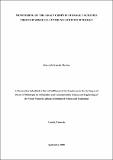| dc.contributor.author | Mazima, Johevajile Kamala | |
| dc.date.accessioned | 2019-06-07T05:59:23Z | |
| dc.date.available | 2019-06-07T05:59:23Z | |
| dc.date.issued | 2018-09 | |
| dc.identifier.uri | http://dspace.nm-aist.ac.tz/handle/123456789/304 | |
| dc.description | A Dissertation Submitted in Partial Fulfillment of the Requirements for the Degree of
Doctor of Philosophy in Information and Communication Science and Engineering of
the Nelson Mandela African Institution of Science and Technology | en_US |
| dc.description.abstract | The storage condition measurement of grain crops is almost non-invasive to date; most of the
technologies can be used to monitor the storage. Electromagnetic radiation is still popular
wireless technique for grain storage condition management. It has led to the way of exploring
safe methods for grain storage. The studies have shown that data detection using
electromagnetic techniques has been attempted from various stances such as invasive and
non-invasive approaches. Most of the existing methods utilize some form of dielectric
techniques. Despite the current development, there is an increasing need for monitoring large
amount of stored grains. The trend indicates the grain spoilage due to the inefficiency of
detecting the climate parameters such as temperature and moisture content from storage of
large amount of grains. The aim of this work is to propose the method capable of monitoring
the storage facility with large amount of grains through wireless communication technology.
It took into account the dielectric and radio refractive quantity properties of grains, and
storage prediction based on hidden Markov for the elegant monitoring of the stored grains.
The model was designed and implemented based on ZigBee technology for remote
communication, where wheat is considered as the prime cereal grains for storage in large
quantity. It is also tested based on the robustness, accuracy and precision to confirm its
viability in real time. The results showed that the proposed method is robust in response to
the climatic changes in the storage and is capable of monitoring the storage condition
accurately with the average range of minimal relative error between -6.67to 6.73% for
temperature and -3.63 to 4.96% for moisture content measurements to both hard and soft
wheat storages. The forecasted results were precisely done over 90% for most of the time.
This justified that the model is capable of monitoring the climatic conditions of the storage
for safe and future use of wheat grains, therefore the proposed model is recommended for the
implementation in real time environment. | en_US |
| dc.language.iso | en_US | en_US |
| dc.publisher | NM-AIST | en_US |
| dc.subject | Research Subject Categories | en_US |
| dc.title | Monitoring of the grain crops in storage facilities through wireless communication technology | en_US |
| dc.type | Thesis | en_US |

